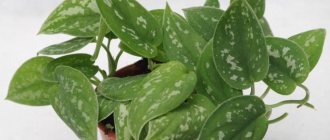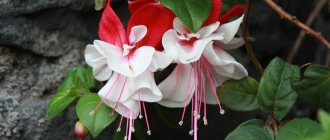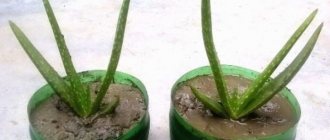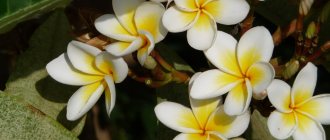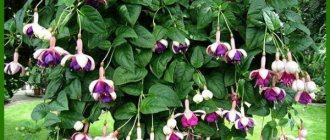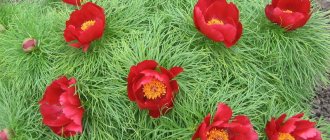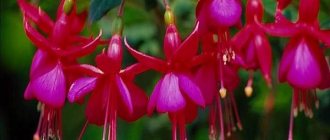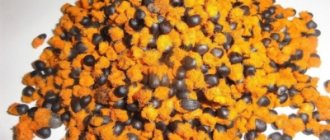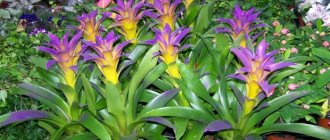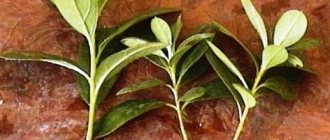It is rare that anyone can pass indifferently past a delicate, graceful plant, “crying” with teardrop flowers of various shades. Thin leaves, exquisite, very unusual flowers, beautiful colors - this is fuchsia. Nowadays it can rarely be found in the collections of flower growers, although previously there was no house in which the hostess would not proudly lead guests to the blooming beauty.
Although, recently interest in fuchsias has begun to awaken. First, the first, timid collections appeared, then the army of fuchsia growers began to grow and get stronger. Selection, propagation, breeding and import of new beautiful varieties from abroad has turned into an interesting hobby, very entertaining and infectious.
Description
There are several stories of “recognition” of a wonderful plant. The first one is somewhat fantasy. On the shores of the Strait of Magellan, a delicate plant has existed for a long time. For local residents everywhere, the growing Thilko was more than familiar. But George Handisid had never seen such beauty before and brought it home. However, the herbarium of the London History Museum has already been decorated with several specimens of fuchsia. This is the second, official version.
A priest and adherent of treatment with medicinal plants, Charles Plumier, in search of a cure for malaria in the foothills of South American Santa Domingo, found a delicate plant with scarlet flowers of an unusual, amazing shape. The found flower received a complex name - TriphyllaFlora Coccinea, which was later somewhat reduced to Fuchsia triphilla, immortalizing in its name the name of L. Fuchs, a German doctor and biologist. According to this version, the year of birth of fuchsia is 1703, it was then that information about the miraculous discovery was published.
The living flower came to England much later - in 1789. Crosses between F. coccinea and Fuchsia Magellanica resulted in the first recorded cultivars, such as Globosa. The variety had red-violet, fairly standard flowers, but even later, researchers and amateurs began to bring more and more new species. Searches in Peru, Mexico, Chile, and Ecuador were crowned with success, the number of varieties increased, and the diversity of the plant began to attract more and more attention from flower growers.
The first variety with snow-white flowering “Venus Victrix” and with double flowers “Duplex and Multiplex” revolutionized fuchsia growing, the plant began to conquer the world.
Fuchsia - a medicinal plant
As a truly medicinal plant, fuchsia, of course, is not used. However, the opinion about its magical, aura-improving, healing properties is firmly among the people. Fuchsia is credited with a number of positive qualities.
Magical properties of fuchsia:
- development of intuition, creativity;
- increased mental and physical activity;
- reducing the risk of exacerbation of chronic and occurrence of acute forms of various diseases (gallbladder, gastrointestinal tract);
Fuchsia in cooking
Surprisingly, fuchsia fruits can be eaten. Moreover, it tastes very interesting – tart and peachy. A skilled housewife makes excellent fillings for pies, jam, even wine and liqueurs from the fruits.
Signs and superstitions
The existing legend gives the plant a particularly mysterious flair and fabulousness. Legend says that fuchsia flowers are nothing more than seven beautiful sisters who fell asleep forever in a whirlwind of a fast dance. Witchcraft destroyed the dancers for not wanting to be in captivity, but now collectors of the most beautiful flower can forever admire this dance.
Poor fuchsia suddenly received another, not very pleasant name: “widow’s tears.”
The existing belief says that the plant “survives” the men at home, but despite this, thousands of happy families watch the extraordinary flowering of this wonderful bush.
Botanical description
Fuchsia is a small tree or shrub. On the flexible branches there are oval leaves, pointed at the end, located oppositely. The bush has the ability to bloom very lushly and for a long time.
The flower is of particular interest. A tubular corolla with bent leaves is surrounded by a bright calyx. The long stamens that look outwards greatly decorate the flower. For this form, the plant was popularly given another interesting name: “gypsy earrings.”
Varieties and types
Ampelnaya
Ampel fuchsia is not a separate variety, it is rather a variety of plant, the structure of which includes various subspecies and varieties. A special feature is the ability of flexible stems to droop, forming a beautiful lush cap, literally dotted with flowers.
Holly's Beauty
One of the famous varieties of ampelous fuchsias is Holly's Beauty, bred in England in 1989. Holly's Beauty is an amazing variety. Quite long graceful buds open into bluish-white double flowers, decorated with thin white threads-stamens. The plant takes root very well.
Blue satin
Blue satin
Also an ampelous form. Very flexible drooping branches, entirely covered with greenish leaves with a red tint. An unusually large flower with a soft purple skirt is complemented by pink sepals with white-greenish tips. To be decorative, the bush must be shaped; in the spring, the plant requires good pruning. With proper feeding, it responds with powerful flowering.
Blue angel
Blue angel
Low, up to 30-45 cm, semi-ampelic fuchsia with very large double flowers. In addition to flowers, the variety is decorated with dark green, slightly jagged leaves and elongated beautiful buds.
The color of the sepals is white, the tips are greenish. The pink coating of the skirt emphasizes the subtle blue of the petals. The scalloped edges give the flower an airy feel.
Cuttings are very easy to root; in suitable conditions the plant overwinters well.
Annabel
Annabel
One of the white princesses in the kingdom of fuchsias. It amazes, especially beginners, with its “porcelain”, fragile-looking flowers. The snow-white skirt bashfully exposes the pinkish stamens, the wreath of slightly pinkish sepals is almost a crown. The leaves are a delicate light green color at first; as they mature, the leaf blade darkens.
An important condition for preserving the decorative effect of flowers is to avoid direct sunlight.
The plant is obedient to formation - right up to the standard. The advantage of this variety is its active growth and early flowering.
Bella Rosella
Bella Rosella
The variety is unique in its versatility. Very fast growth with a powerful growth of non-fragile shoots allows you to form a plant, both in the form of a standard and in an ampelous form.
Very large flowers, with an intense pink, even purple, skirt and a delicate white-pink “crown” of sepals turn a “tree” or a lush bush into lacy foam. The flower is worthy of becoming an adornment of the most exquisite collection.
Royal mosaic
Royal mosaic
One of the most common and favorite varieties of fuchsias. Very large, “fluffy” (double) flowers are original in color and shape. The blue-violet skirt, rich in tone, is set off by pink “strokes-splashes”. The sepals are white on top and, when fully opened, show a pink underside, which looks very decorative, especially in combination with rounded large white buds. The background is also beautiful - slightly jagged, bright shades of green leaves.
It blooms luxuriantly and grows intensively - a wonderful variety in all respects, both for amateurs and professionals.
New Millennium
New Millennium
This is an amazing, very original and unusual variety. Bushy, beautifully and quickly branching, fuchsia lends itself well to shaping. But the view of a flowering plant is especially good. On a light green background of thin leaves, surrounded by large lilac buds, double flowers of unusual colors bloom.
The dark red (to black) skirt becomes cherry at the end of flowering, but seems to glow from the inside.
The red sepals add a glow and wonderfully frame the center of the flower with its long, graceful stamens.
Voodoo (voodoo)
Voodoo (voodoo)
It is distinguished by its unusually beautiful colors, contrasting and very bright. The dark purple skirt surrounded by intense red sepals and heart-shaped buds immediately attracts attention. The remaining qualities are also good - power and speed of growth, abundant flowering, easy formation. The variety is suitable for beginner gardeners.
La campanella
La campanella
A small-flowered but profusely flowering variety, usually grown in a hanging form. White sepals above a lilac skirt look like lavender mist enveloping a lush bush.
Types and features of fuchsia
The first to give a detailed description of fuchsia was the famous biologist Charles Plumier in 1696. The plant received its name in honor of its discoverer, German biologist Leonardo Fuchs.
The plant is a small tree with flexible or shrub with thin branches. Fuchsia has small, entire, oval or lanceolate leaves with a sharp, sometimes jagged edge.
The leaves of most plant species are light green, but some hybrid forms may have a darker color with a reddish or purple tint. The color and structure of the fuchsia inflorescence is quite diverse, the structure of the flower is complex.
Flowers have a variety of shapes: combined or double. Small-shaped flowers are collected in racemose inflorescences, or single flowers in a hanging form. In hybrid forms, dual colors of flowers are allowed, each of which has a corolla-shaped calyx with bent edges.
The duration of the flowering period is long and with proper and regular care you can admire the decorative and lush flowering already at the end of spring or at the very beginning of summer.
The fruit is a large, juicy berry that appears immediately after flowering. Thanks to breeding work, new upright and hanging varieties of this plant species were developed.
Fuchsia is one of the favorite and popular plants among many gardeners due to its variety of decorative forms and ease of care; moreover, this plant can be successfully grown as a house plant or in open ground.
Hanging varieties look original in hanging baskets and flowerpots.
The most common varieties are the following varieties - fuchsia Bolivian, Magellan, graceful, corymbose, sparkling, thin, trifoliate and hybrid. Fuchsia is a rather unpretentious plant that even an inexperienced gardener can grow.
How to care for fuchsia at home?
Fuchsia, in general, is not a demanding plant and is quite grateful for care at home. In city apartments, if a number of conditions are met, it can be grown very easily, achieving good flowering and excellent decorativeness.
The soil
For fuchsias, light, loose and very nutritious (due to constant, intensive growth) soil is best suited. A mixture of peat, humus, compost and sand is suitable. A small addition of superphosphate (about 0.5%) and ash (about 1-3%) will provide the plant with nutrition.
It is necessary to put drainage at the bottom of the container, since fuchsia roots suffer greatly from stagnant moisture.
Light
Despite the opinion that fuchsias are shade-loving flowers, the plant still loves light. The only thing is that direct sunlight should not be allowed. The shades of flowers suffer from sunlight and the leaves turn yellow. Blinds will perfectly protect you from excessive lighting, and fuchsias feel best on eastern and western windows and balconies.
Watering
The plant really does not like excess moisture. A flooded fuchsia drops its leaves and dies very quickly; it is practically impossible to restore.
Proper watering includes:
- checking the ground. It should become almost dry, but for a very short time. Overdrying the soil is also detrimental to fuchsia;
- checking pallets. Under no circumstances, even in hot weather, should water stagnate in the pan;
- shower device. There is an opinion that fuchsia is a “rainy plant”. It's not entirely true, but the flower loves showers. The plant will respond to moderate spraying with lukewarm water with elastic greenery and lush flowering;
- selection of water for irrigation. Water for irrigation should be at room temperature or slightly lukewarm, settled.
Feeding
Fuchsia loves feeding very much. According to experts, it is necessary to feed the plant according to the principle “often, little by little.”
A weekly application of fertilizer suitable for the period (stage) of flower development is quite sufficient.
Plants during periods of intensive growth, especially young ones just beginning to grow, need nitrogen. Complex, specialized formulations, such as Planta, are suitable.
At the beginning of flowering, it is very good to feed with phosphorus and potassium. Complexes for flowering plants (“Kemira”) are rich in it.
How does it reproduce?
It is best to propagate fuchsia in March or at the end of August and September. Summer is not the best period for this procedure, because the heat can be destructive for fuchsia. Planting material often rots.
What to grow in?
To propagate fuchsia you need to use a ceramic pot . It shouldn't be too big. Later, during transplantation, its size gradually increases.
The color of the pot matters. If it is light, then the sun's rays will not accumulate; in dark ones, heat accumulates, which is undesirable for the flower.
Fuchsia prefers to grow in loose, neutral soil . The best is considered to be the one that contains an equal amount of:
- peat;
- humus;
- sand;
- turf and leaf soil.
Advice : You definitely need good drainage - expanded clay or fine sand. A newly planted flower does not need feeding, because it is planted in soil that is well prepared and saturated with the necessary microelements.
How to propagate by leaf
- For propagation, large leaves are prepared, which must be taken from a healthy flower. They must be taken with a cutting and part of a shoot with an axillary bud.
- The first step is to prepare the soil that needs to be moistened.
- A recess is made in the center where the planting material is carefully placed.
- The top of the leaf should be sprinkled with a little earth; there is no need to compact it.
- To create greenhouse conditions, the pot is covered with a film, which is periodically opened for ventilation.
- When the soil dries out, water it.
- After 15-20 days, the plant will begin to grow roots. From this time on, it is left open all day, covered with film only at night.
- After small rosettes appear from the base of the stem, the young plants can be transplanted into separate pots.
Care during this period
For rooting of planting material, it is necessary to create suitable conditions . The pot should be in a well-lit place, but the leaf should not be exposed to direct sunlight. It is advisable to place it on a windowsill located on the east side.
It is unacceptable to wet the soil too much, but you should not allow it to dry out. The optimal humidity for fuchsia propagation is 80-90%. This is exactly the indicator that polyethylene film can maintain. For good growth, you need to spray the planting material daily with warm, settled water.
In the summer months, the optimal temperature for fuchsia propagation should be +18...+24 °C, and in winter - +10...-+12°C.
In the future, you need to choose the right pot, otherwise the plant will not bloom . You need to choose according to the size of the roots, which should wrap around the entire soil ball.
An equally popular method of plant propagation is cuttings. Read about the advantages of this method over sowing seeds in our article on planting fuchsia.
How to trim and pinch fuchsia?
Pruning and pinching fuchsias is a necessary technique to increase the intensity of flowering. Thanks to these operations, the number of shoots bearing buds increases.
Pinching the cuttings
A young plant is usually pinched three times, each time removing the growing points of new shoots. The first time, pinch out one existing shoot. The second time - the growth points of two newly formed cuttings are pinched again (there are already two of them). And the third time, having cut off all the growing points, they get a fairly fluffy bush with many shoots formed.
Duplicate pinching
The method allows you to form a plant very quickly. New shoots are pinched without waiting for the internodes to grow. This method of formation must be done carefully, since the mass of branches formed is very large.
You can pinch the plant at any time of the year, the only condition is that the formation must be stopped two months before the expected flowering.
Feeding fuchsia
How to feed petunia for abundant flowering
When the green mass is lush, but there are few buds, fertilizing the fuchsias helps to increase the flowers.
Follow the rules:
- feed only healthy plants;
- sick crops are first treated, then fertilized;
- 2 hours before fertilizing, moisten the soil;
- from November to spring the plants are not fertilized;
- A newly transplanted young plant is not fed so as not to burn the roots.
Fuchsia after feeding
Organic fertilizers
Choose from the list what organic material to feed fuchsias with:
- fertimix. Water 2 times a month (20 g per 1 liter of water). Fertilizer based on vermicompost helps to form buds and gives the leaves a bright green color;
- bone flour. Apply once a month to the top layer of soil;
- "Living force for flower crops." Contains humic acids. Irrigate 2-3 times a month (10-30 g per bucket of water). Water at the root (30-50 g per bucket) twice a month;
- peat oxidate. With a 1% solution, foliar feeding is carried out weekly.
Mineral compositions
During the flowering period, fuchsia needs to be fed with mineral fertilizers:
- “Bud” - sprayed once a week. Helps to bloom, flowers become richly bright;
- "Uniflor-bud" - for a large number of buds. Spray once a week;
- "Spring Effect", "Planet Miracle Growth". Dissolve 5 g of the drug in 2 liters of water and leave for 24 hours. Spray once a week;
- Kemira Lux. Water 3 times a month (1 g per 2 liters of liquid). The drug increases the plant's immunity;
- Pocon, zircon are growth stimulants. For 1 liter of water take 10 ml of fertilizer.
Homemade products
In addition to ready-made preparations, gardeners use folk remedies to fertilize indoor plants:
- wood ash. 3 tbsp. spoons, pour 1 liter of liquid, leave for a week. Water at the root;
- succinic acid. One pharmaceutical tablet is dissolved in a liter of water. Suitable for root and foliar feeding to help the crop bloom;
- eggshell. The powder is added to the substrate when the flower is replanted;
- banana skin. Dried, crushed, added once a month to watering;
- tea leaves Dry and mix with soil when planting.
Note! The flower requires care during the active period and the dormant period. But not all gardeners know what to do with fuchsia in winter after flowering. The flower is brought into the house and not fed. Old branches are trimmed and watered rarely.
Fuchsia is an unpretentious house flower. For abundant flowering, you need to love it and follow basic care conditions. This includes watering, proper lighting, fertilizing in the form of organic and mineral fertilizers, treatment for diseases and pests.
How to form a standard fuchsia?
A real tall tree (up to 1 meter in height) can only be obtained in natural conditions or in special greenhouses, since the trunk needs good and, most importantly, uniform lighting. In an apartment, this interesting activity will also lead to results, but the tree will be small.
To form a trunk you need:
- choose a suitable cutting. It should be strong, rooted, and, preferably, upright;
- tie the cutting to a high peg;
- feed with fertilizers containing mainly nitrogen. Further, during formation, it is necessary to use only such fertilizers;
- place the cutting in the light;
- as they grow, remove all buds and shoots (lateral);
- after waiting for the required height (about 1 year), pinch the top;
- Then pinch the resulting crown according to the usual rules.
When forming a trunk in a city apartment, fuchsia must be turned towards the light so that the crown is uniform.
Protection from pests and diseases
Pests generally begin to appear in the spring, so you should take good care of the plant, carrying out regular thorough inspections. The most serious enemies are whiteflies and aphids. When they appear, the plant should be treated with special insecticides. It should be sprayed under the root and on top (sometimes covered with a bag for complete protection).
Very bright, multi-colored indoor fuchsias are the favorite flowers of many gardeners. They are not too demanding to care for, although there are some nuances. The main thing is to choose the right variety, pinch it regularly and monitor the appearance of parasites.
How to propagate fuchsia?
Cuttings
The best and fastest way to propagate fuchsias at home is by rooting cuttings. You can take any cuttings, even the tops remaining after the formation. But best suited, especially for beginners, are mature shoots 9-12 cm long, with two or three pairs of leaves.
Progress
1) Prepare:
- containers with water or soaked peat tablets placed in cups;
- cuttings with lower leaves removed;
- plastic bags or cans (for the “greenhouse”);
- artificial lighting (this is especially true in winter).
2) Place the prepared cuttings in a container with water or insert into a tablet.
3) Place on pallets, cover with a bag (or jars), and place in a warm place.
4) Organize lighting. Rooting of cuttings occurs in the second or third week.
Seeds
The seeds extracted from the fruit must be dried. After two or three days, sow the dried seeds on a light nutrient substrate, cover them with glass or film (they cannot be embedded in the ground). Place the sown substrate in a warm, illuminated place.
After two to three weeks, when the seeds have sprouted, make the greenhouse higher, but it is not recommended to open it completely. Seedlings that are one and a half to two months old should be planted a little further from each other. Gradually accustom the grown seedlings to the open air, opening the greenhouse slightly.
Fuchsia propagation
Three methods of propagation are used: seeds, leaves and cuttings. The first two methods are used much less frequently. But this does not mean that they are less effective. They are just more labor-intensive and take much longer to get results. Beginner gardeners (and experienced ones too...) prefer propagation by cuttings. That's where we'll start.
Propagation of fuchsia by cuttings
This can be done both in spring and autumn. Autumn propagation (August-September) is used mainly for slow-growing varieties. Most often, cuttings are taken in February-March, in which case flowering may occur in the same year.
- Cuttings for propagation are taken small (6-10 centimeters long) from the top of the plant, cutting them off under the lower bud.
- The lower leaves must be removed, leaving 3, maximum 4 pairs. If the leaves are too large, they can be cut in half
- You can root cuttings in loose (peaty) soil, in wet sand, and in water. For beginner flower growers, I would recommend the last method, for clarity.
- The container with the cutting should be covered with a glass or any other transparent cap.
- After about 20-25 days (possibly earlier), the cutting will produce roots sufficient to be planted in a pot. For young fuchsias, the composition of the soil should be as nutritious as possible. A mixture (in equal parts) of leaf, turf, humus soil and sand is recommended.
Note. Summer is not the best time to propagate fuchsia from cuttings. She doesn't really like high temperatures. Therefore, if you decide to propagate it in the summer, you should do this in a cool room. For example, where the air conditioner is located.
Propagation of fuchsia by leaf
- In this case, you need to take not just a separate leaf, but cut it off with a small piece of the stem.
- The petiole with a piece of stem is buried in the ground (about 1 cm). To do this, you can take the nutrient mixture described above.
- The soil and leaf are moistened and covered with a transparent cap (jar, PE bag, etc.).
- For better rooting, the leaf should be sprayed daily.
- After the young rosettes of the plant appear, they can be replanted.
Why does fuchsia shed its leaves and buds?
There may be several reasons for this beauty’s behavior.
Main reasons:
- moving a plant from place to place;
- improper watering;
- unsuitable air temperature in winter (too high, “not winter”);
- improper watering (overwatering, over-drying);
- drafts;
- pests;
- incorrect pinching.
In order to determine the specific cause, you need to take a very close look at the plant. Only the florist himself, having understood the situation, can find a way out. For example, organize a proper “wintering” in a slightly shaded place at a temperature of +10...+12°C, removing the pot from a draft or optimizing watering.
How to make fuchsia bloom?
The reasons that fuchsia does not bloom are almost the same as described above. You can only add incorrect fertilizing (abuse of nitrogen, for example, leads to an increase in excess green mass), as well as pinching (formation must be stopped one or two months before flowering).
Only all measures in combination will help to make your pet bloom:
- Transplant the fuchsia into a tighter pot;
- Water as the soil dries out;
- Organize proper lighting - a calm, bright place with diffused rays;
- Feed with phosphorus and potassium, removing nitrogen fertilizers from the “diet”.
How to replant after purchase?
To properly transplant a newly acquired fuchsia you need:
- prepare loose, fertile soil, place the fuchsia in a pot with a drainage mixture at the bottom;
- examine the plant; remove all damaged, dry parts (leaves, shoots). Also remove buds and flowers;
- remove the fuchsia from the purchased container and examine the root system. If necessary, cut off rotten and damaged roots, sprinkle them with ash;
- carefully place the flower in the soil, straighten the roots and sprinkle with soil, layer by layer;
- Lightly press the soil;
- water with settled water;
- place the plant in a shaded place for the adaptation period (1-2 weeks).
Rules for planting fuchsia
You cannot plant an adult fuchsia or a plant cutting straight into a large pot. The size of the container should increase gradually. Initially, the diameter of the pot should not exceed 9 cm.
As the root system envelops the entire earthen ball and the need to replant the flower arises, you can prepare a slightly larger container . The transplant is performed as follows:
- A good layer of expanded clay or other drainage material is placed on the bottom.
- A layer of soil is poured on top and a prepared bush or plant cutting is planted.
- The pot must be well filled with soil so that voids do not form between the walls of the container and the root system. To do this, you need to carefully shake the pot and knock on its walls, but under no circumstances compact the substrate with your hands.
For fuchsia to grow consistently, porous soil is as important as good drainage.
Growing and caring for the garden
Fuchsia will greatly decorate the garden. There is a place for it near the pond, in the patio, and against the walls of gazebos in hanging forms. Corners of lightly shaded areas where there is no wind will take on a mysterious and elegant look if “dancing” flowers of different shades decorate them.
However, you must understand that fuchsia does not tolerate middle zone winters.
This is a heat-loving plant, so caring for fuchsia at home involves organizing wintering. But during the summer, planted in the soil in June, the plant quickly gains growth and flowering, especially with proper watering and good fertilizing. Within 2-3 weeks after planting, fuchsia will decorate the house with flowers.
And only before the first frosts, the beauty must be transplanted, first into a greenhouse, and then, for final dormancy, into a relatively warm place (for example, in a well-lit place in a basement or garage at +10...+12 °C).
If you want to use this type of soil, it is much easier to prepare it yourself if you have a sufficient supply of fertile loamy soil. To the John Inn formula described above, add the required amount of basic fertilizers. These are described below for soilless and multi-purpose soils. In practice, the advantage of soil-based soil is its weight: plants grown outdoors cannot be easily knocked over by the wind; its density: the roots cannot easily reach the inner wall of the pot when they try to reach for the “drip line” and a stable supply of nutrients, regulated by the periodic rise and fall of soil temperature. The overall result is a healthy and well-balanced plant. An additional advantage is the moisture-retaining qualities of the soil on hot sunny days.
Restrictions on the use of soil-based soils have led to the introduction of multi-purpose peat and other soilless soils. There are many of them, from coconut fiber to composted plant and other materials. They all have their own disadvantages and advantages, which can only be determined as such soils are used. Try using them. In addition, inactive materials such as perlite or vermiculite can also be used using a technique called hydroponics. This is a new and exciting way to grow plants in an aqueous solution containing all the necessary nutrients. If you want to use multi-purpose peat soil or other soil on a soilless basis, you will understand what restrictions there are on their use. The upside is that they are relatively cheap, easy to find, lightweight, clean to handle, very versatile to use, and available in a variety of formulations. The negative point is that the nutrients are mainly dissolved in water and will support the plants for a limited time, depending, of course, on the time of year. In summer, they quickly dry out and shrink, making them very difficult to re-moisturize. When the soil dries out, plants in pots with such soil can be easily knocked over by the wind and damaged. Another problem is the roots. In the absence of obstacles in the soil that can change the trajectory of their growth and movement, they will be drawn directly to the inner wall of the pot, along which they will “circle” in the pot in order to find the “drop line”, while the middle of the earthen coma will remain for some time untouched. The “drip line” is, of course, the outer edge of the crown. In nature, raindrops fall from one leaf to another until they hit the ground. This is the drop line where the roots expect to find nutrition and moisture. As soilless soils become depleted of nutrients, these reserves must be replenished with additional feeding using liquid fertilizers to maintain balanced growth and development. Adding additional fertilizing is a blind move that invariably does more harm than good if you are not an expert. Many plants die or develop poorly due to improper use of mineral fertilizers, which by their nature have a high degree of acidity. Due to the excess concentration of such fertilizers, the roots are burned and the soil sours. When applying the solution, the plant has no choice but to absorb the dissolved fertilizers. If this happens, you will notice a white coating appearing on the outside of the leaf. This happens during the evaporation of moisture from the surface of the leaf, and the white coating is excess fertilizer that the plant does not need. Simply put, the plant is “sick.” It would be more prudent to add additional organic or slowly soluble mineral fertilizers to the soil and give the plant the right to choose what it needs. Another type of fertilizer that may be considered is osmocote, a liquid fertilizer contained in chemically or biodegradable shells of varying thickness. I have used such fertilizers with limited success. Mineral fertilizers in solutions leave plants no choice but to absorb them, and if applied at the wrong time can lead to disaster. The plant is a much better judge of when it needs to feed. A plant's nutritional habits are determined and controlled by two factors: soil temperature and light intensity. Adding organic and mineral fertilizers to the soil will ensure healthy, balanced growth and flowering without having to decide whether to feed or not. The only time to even consider supplemental feeding is when the plants are in their “final” pots and containers and well rooted.
It is necessary to consider previously raised questions about the disadvantages of both types of soils. The structure of multi-purpose and landless soils needs to be changed for their use by specialists. It is necessary to add: weight, additional fertilizers, materials to change the direction of root growth and means for soil ventilation. Ventilation is something that almost all amateurs and professionals in growing plants forget about. What is not taken into account is that when using soilless soil, the roots developing inside the pot or container grow and expand, compressing the soil. As soil compression increases as the plant grows, the supply of oxygen needed by the roots and microorganisms living in the soil is depleted. The result is compressed, compacted soil with almost no drainage or oxygen. The soil turns sour and the microscopic roots responsible for nutrition are attacked by a fungus living in the water. When a plant shows signs of illness, two assumptions are usually made. Either the plant needs food, or the plant has been flooded. The assumption is correct, but the way to deal with the problem is almost always wrong. Watering and additional fertilizing will only accelerate the death of the plant. Before trying to help the plant, remove it from the pot and check the root system. This will tell you everything. If the roots are white and healthy, everything is fine. If they turn brown with obvious signs of decomposition, then you have discovered the real problem. The cause will be soil compression leading to flooding or poisoning due to overfeeding or a combination of both. Until the real reason is determined, the situation will repeat itself. This is a waste of both time and money, especially if you bought a plant to replenish your collection. To eliminate such problems, try using the primer formula described below. It was developed over five years in order to solve and avoid most of the problems listed above. Interesting idea. There has never been and never will be a soil that can turn a poorly grown, neglected plant into a showpiece, or that can turn an inexperienced beginner into an expert. To be successful, in addition to good soil, you need to care for and understand your plants. Plants, like you and me, are made of living tissue and must be treated with respect. Don't offend them, and they will reward you generously.
Soil composition
I have used the following soil composition for 35 years, not only for fuchsias, but for my entire collection of more than 30 plant species. They all grow and bloom, showing spectacular results. When showing plants at exhibitions, I never disclosed the composition of the soil or the formula of nutrients, and rarely did anyone manage to beat me at exhibitions. By using the same soil composition and nutrient formula, I could predict the behavior of my plants year after year. The only unknown element was the weather. If you would like to try my formula, I want to emphasize the importance of reading it carefully and paying particular attention to the warnings.
First decide what type of soil you want to use. It does not matter what type it will be - soilless, multi-purpose peat or soil with an earthen base, prepared according to John Inn's formula - 7 parts fertile loamy soil, 3 parts peat and 2 parts coarse sand. I have used a combination of soilless soil and soil-based soil on occasion with success. Soil has two main functions. The first is the place where the plant is anchored by its root system, the second is the retention of nutrients and moisture.
Proportions for soil based on 40 liters.
For every bushel measured of soilless or multi-purpose peat soil, add two 5-inch pots of coarse sand. This will add weight and provide material to deflect root growth. Two 5-inch pots of perlite or vermiculite. This will prevent soil compression and improve ventilation and drainage. This will also help moisten the soil when it dries out. (Note: If the soil is dry, always moisten it with warm water. It penetrates the soil better than cold water and allows the plant to recover faster). Moisturizers are now available that can be added to the soil if desired. Lack of ventilation and soil compression are the main causes of plant death. If using John Inn's soil, add only perlite. After preparing the soil, it is necessary to enrich it with basic nutrients, the amount of which will depend on what the soil will be used for.
Please pay particular attention to the following paragraphs and the warnings they contain.
The main fertilizers that need to be purchased and added to the soil are:
Coarsely ground hoof and horn meal. Lime superphosphate. Potassium sulfate. Steamed or finely ground bone meal. Magnesium sulfate. Manganese sulfate. Having purchased these fertilizers, the first thing to do is open each package and sift everything through a flour sieve. Then pour the contents of each package into a waterproof container and label it. Anything that has not passed through a sieve can be used in the garden; it is not suitable for potted crops.
Only after sifting, all fertilizers are weighed individually and then mixed in the proportions indicated below. Once mixed, fertilizers should be stored in waterproof containers. It is interesting to note that I have never seen or heard anyone write about the need to carefully measure mineral and organic fertilizers added to the soil for potted plants. Failure to follow this instruction will cause an imbalance in the release of fertilizer and will negatively affect plant development. Any substance, especially organic matter, that will not pass through a flour sieve is too large to be added to potting soil. It will take too long to decompose and is therefore best used in the garden.
The main fertilizer consists of the following ingredients
, which must be sifted through a flour sieve before mixing and using.
Diseases and pests: treatment methods
Pests
Whitefly
Attacks fuchsia under conditions of overheating and waterlogging. Larvae hatched from eggs on the lower parts of the leaf blade suck juices from the tissues, and pathogens of fungal diseases thrive on the secreted sugary substances.
Control measures: physical removal of eggs and larvae, washing in soapy water with the addition of garlic infusion helps. Special means are also effective, for example, Aktara, etc.
Spider mite
The appearance of cobwebs on the leaves and drying out of the shoots will indicate that the mite has already attacked the fuchsia.
Control measures: it is necessary to remove all damaged parts of the plant and treat with Fitover.
Diseases
Root rot
Brown softened roots are the first sign of the disease, which then manifests itself in wilting and general depression of the plant.
Control measures: remove all rotten roots, rinse the root system and place the plant in a container with clean water. Wait for new roots to appear and replant in clean, newly formed soil.
Rust
Brown, dark, unsightly spots on leaves are a sign of this nasty fungal disease carried by spores.
When the first symptoms appear, move the fuchsia to another place, separately from other flowers, wash it with soapy water and treat it with antifungal drugs (fungicides).
Fuchsia is a real unique plant in terms of splendor, brightness and variety of flowering. If all the rules of agricultural technology are observed, this amazing flower will not only delight its owners with its exquisite and varied beauty, but also improve the psychological climate, since this guest from warm countries has the ability to bring wisdom and peace to the walls of the house that shelters him.
